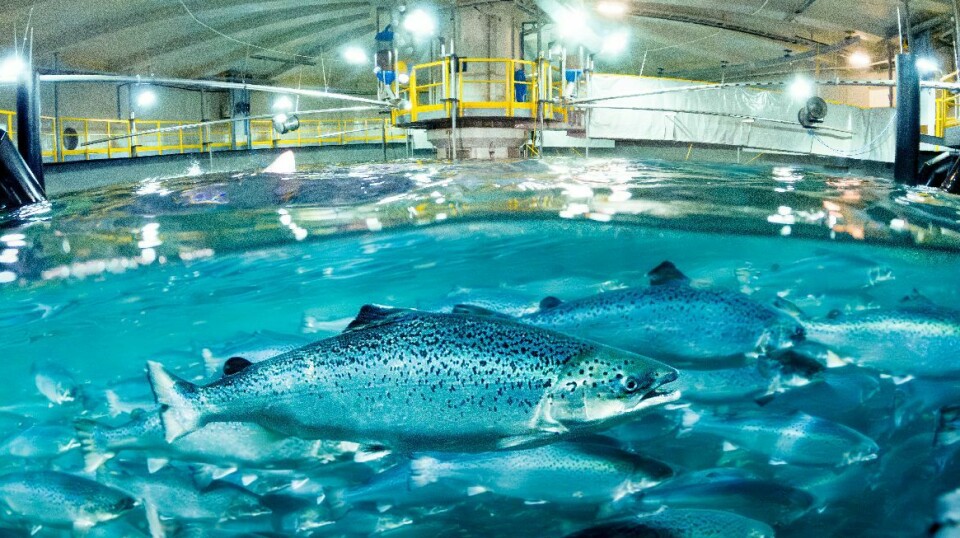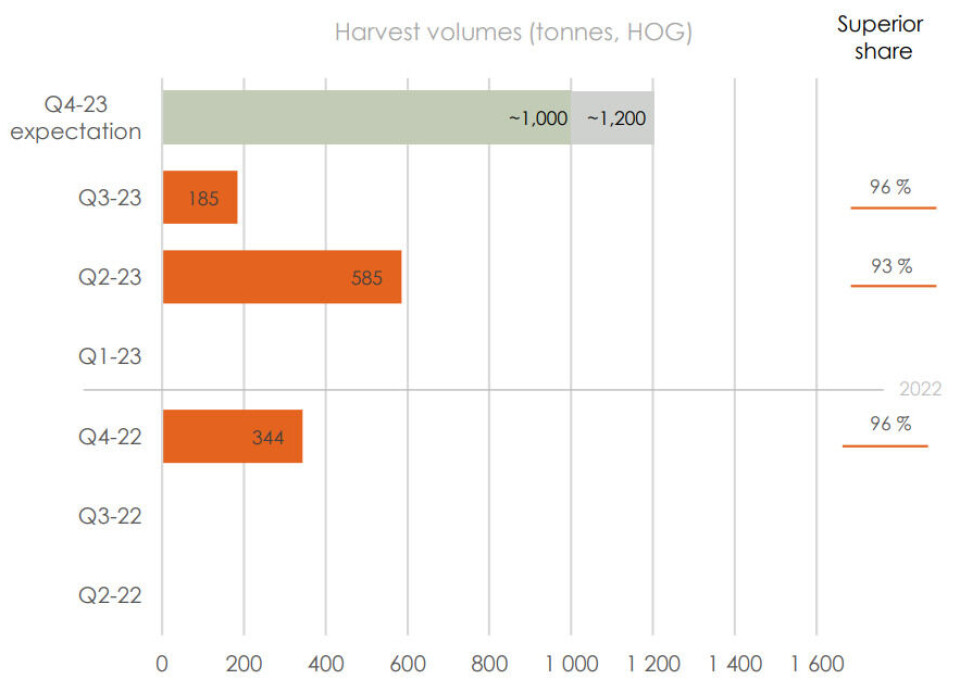
Standing biomass doubles for Salmon Evolution
Land-based salmon farmer expects to harvest up to 1,200 gutted weight tonnes in Q4
Land-based fish farmer Salmon Evolution more than doubled standing biomass in phase 1 of its hybrid recirculation/flow-through facility in Norway, it said in its third-quarter report today.
Standing biomass at the end of September was 2,100 tonnes, up from 1,047 tonnes at the end of June.
The company said that part of the third batch of smolts stocked at the facility were harvested in September and yielded 185 gutted weight tonnes with a 96% superior share, tight weight concentration and good price realisation of around NOK 72 per kilo.
It expects a significant increase in harvest volume to between 1,000 and 1,2000 gwt in the current quarter, and said it is on track for production costs that match those in conventional net pen farming.
1.5 million fish
Batch 8 was stocked at the end of August and batch 9 at the end of October, bringing the plant to a stable number of individuals of 1.5-1.6 million, which is the number of fish Salmon Evolution requires for full steady-state production. Batch 10 will be stocked next month, setting conditions for streamlined, fully stocked production.

Phase 1 of the facility on the island of Indre Harøy has a capacity of 8,000 gwt per year, and groundworks are under way on a second phase that will double capacity. A 16,000-gwt third phase, planned for 2028, will increase overall production capacity to 32,000 gwt per year.
Salmon Evolution has operated the facility on the island of Indre Harøy since March 2022. In Q3, the company said it experienced good biological performance and had a mortality rate of 1.5%, indicating that that the company is well on its way to achieving a mortality rate of between 3-5% annually.
“Compared to the rest of the industry, where the mortality is on average around 15-16%, it gives us a big advantage also when it comes to production costs. And for fish welfare, perhaps mortality is also the most precise measure of that,” said chief executive Trond Håkon Schaug-Pettersen during a presentation of Q3 results.
Earmarked for harvest
At the end of the quarter, the remaining part of batch 3 numbered about 84,000 individuals with an average weight of about 3.205 kilos, representing a biomass of 268 tonnes (live weight). The company expects to harvest these fish in Q4.
Batch 4 numbered about 178,000 individuals with an average weight of about 3.98 kilos, representing a biomass of 708 tons (LW). The first part of batch 4 was harvested in early October, and the remainder is expected to be slaughtered later in the quarter.
Batch 5 numbered about 247,000 individuals with an average weight of about 2.44 kilos, representing a biomass of 602 tonnes (LW). The first two tanks in batch 5 are expected to be harvested in Q4.
Good start
Salmon Evolution said batches 6 and 7, stocked at the end of May and the end of June, have had a good start at the plant. Both batches were stocked with weights slightly lower than the target size due to low water temperatures during the winter season at the company’s Dale smolt plant. The group has installed more heating capacity at Dale, which has been in operation since October. This is expected to have a positive effect on the ability to deliver smolt of a similar size in the future.
Batches 6 and 7 numbered around 268,000 and 275,000 individuals, with an average weight of 790 grams and 490 grams respectively. Together, they represented a biomass of 347 tonnes (LW).
Batch 8 was released during the quarter with an average weight of 90 grams. As with batches 6 and 7, this was slightly lower than the target size. The group has done very well after the transfer from the smolt facility, with good appetite and low mortality. At the end of the quarter, there were 275,000 individuals with an average weight of 205 grams, which represents a biomass of 56 tonnes (LW).
So far this year, Salmon Evolution has had an income of NOK 79.6 million (19.2m year-to-date 2022).
Operational EBIT YTD is NOK -97.4m (NOK -45.9m YTD in 2022).






















































